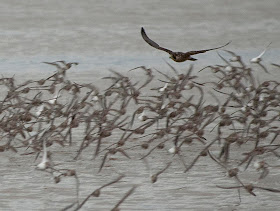
This is what happened to us near Edison in Skagit County on January 2, 2010. A large flock of Dunlins (around 4,000) was feeding and roosting in the flooded fields along the Bayview-Edison Road, not far from Skagit Bay, so we stopped to watch them.
Almost immediately the flock flushed, and a Merlin flashed through them. It didn’t get one, then disappeared, maybe because too many of its big cousins were in the area. In the hour and a half we spent at the spot, we saw three different Peregrines.
An adult male and an adult female stooped on the flock several times each, scattering the sandpipers like confetti. But it was confetti with a purpose, as the birds flushed and then became dense moving objects, oscillating back and forth over the landscape in alternating brown camouflage and white flash as they showed their upper- or undersides.
One would think any capture would be because of a random meeting in the air, but the falcon often jinked sideways or up or down slightly, presumably going after an individual bird each time. Their success rate was low; we never saw either bird catch a Dunlin, but a bit later we saw the female eating one, so she must have succeeded when we weren’t watching.
The biggest show was put on by a young female, easily distinguished because of her brown upperparts and striped underparts. She shot through the Dunlin flocks again and again, stooping perhaps 25 times as we watched. A lightning pass at eye level, sometimes coming within 50 feet of our car, then up and down again for another pass. She never picked one out of the air, but then we saw her circle around and pick one up from the water, presumably a casualty of her strike or a midair Dunlin collision.
We saw a Glaucous-winged Gull carrying a Dunlin in its bill, presumably another bird that hadn't survived the aerial confusion.
The biggest show was put on by a young female, easily distinguished because of her brown upperparts and striped underparts. She shot through the Dunlin flocks again and again, stooping perhaps 25 times as we watched. A lightning pass at eye level, sometimes coming within 50 feet of our car, then up and down again for another pass. She never picked one out of the air, but then we saw her circle around and pick one up from the water, presumably a casualty of her strike or a midair Dunlin collision.
We saw a Glaucous-winged Gull carrying a Dunlin in its bill, presumably another bird that hadn't survived the aerial confusion.
It was impossible to follow a stooping falcon with the camera lens, but by focusing into the middle of the Dunlins and hitting the shutter button just as the immature Peregrine passed, I managed to get a few photos during the attacks. The two adults obligingly posed for photos on nearby utility poles.
There was also a nearby Prairie Falcon that we never saw harass the Dunlins, perhaps because it already had something for lunch. A male Northern Harrier also passed through the waves of Dunlins but with no luck.
What a way to begin the New Year!
Dennis Paulson








Is any damage done to the Falcons when they make contact with their prey at such high speeds? It is remarkable that they themselves are able to stay in the air after such collisions.
ReplyDelete-Dominic